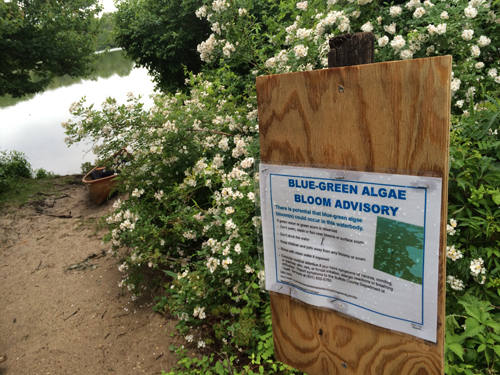
Recent testing by SUNY Stony Brook has confirmed the presence of cyanobacteria, or blue-green algae, in Lake Marratooka in Mattituck. Health officials are asking that people avoid contact with the contaminated water and to keep children and pets away from the area. An average of six Harmful Algal Bloom (HAB) reports have been issued per year at Lake Marratooka since 2020.
Southold Town Supervisor Al Krupski said that the local Canada goose population was at least partly to blame for the cyanobacteria levels. “We have repeatedly asked New York State DEC to help with the control of these waterfowl,” Mr. Krupski said. “The nutrients and pathogen loading is really attributable, a lot of it, to wildlife. And that’s something that we could solve.”
Mr. Krupski also emphasized the town’s commitment to clean water. “As a town, we’ve been very aggressive in water quality efforts, especially trying to prevent road runoff, which carry bacteria and nutrients also into the lake. The town’s been very conscious of all our water bodies and trying to improve water quality. If there are any improvements that we could make as a town, whether it’s stormwater remediation or anything else, we’d be certainly be willing to do that.”
Blue-green algae is naturally present in lakes and streams, but certain conditions such as an overabundance of nutrients, slow moving water and warm temperatures can cause a “bloom.” This overgrowth can produce mats or scum on the surface of the water and give off harmful toxins. These algal blooms can be shades of green, blue green, yellow brown or red.
Residents should avoid contact with waters that appear scummy or discolored. If contact does occur, rinse off with clean water immediately. Seek medical attention if you experience any of the following symptoms: nausea, vomiting or diarrhea; skin, eye or throat irritation; allergic reactions or breathing difficulties.
Blooms may release a fast-acting nerve toxin that can be dangerous for pets, particularly dogs that swim within blooms. The toxic cells can stick to animal fur and become concentrated when ingested. Symptoms of HABs exposure for dogs include stumbling, seizures, convulsions, paralysis; excessive salivation or drooling; disorientation, inactivity, or depression; and an elevated heart rate and difficulty breathing. If you see or suspect any of these symptoms, particularly within a few hours of exposure, seek immediate veterinarian care.
To report a suspected blue-green algae bloom in a body of water with a Suffolk County-permitted bathing beach, contact the Suffolk County Department of Health Services’ Office of Ecology at 631-852-5760 between 8:30 a.m. and 4:30 p.m. or by email at any time at [email protected]. To report a suspected blue-green algae bloom at a body of water without a Suffolk County permitted bathing beach, email the New York State Department of Environmental Conservation (NYSDEC) at [email protected].

